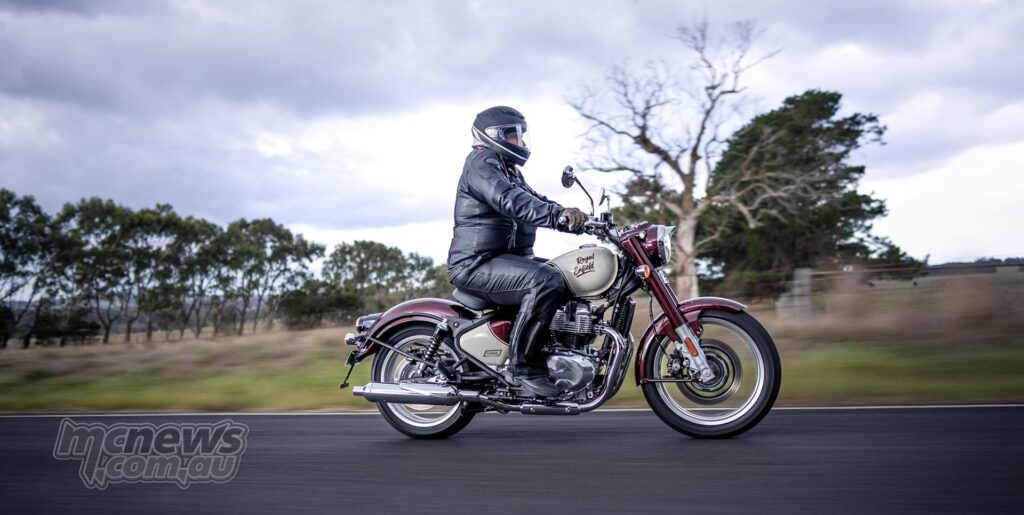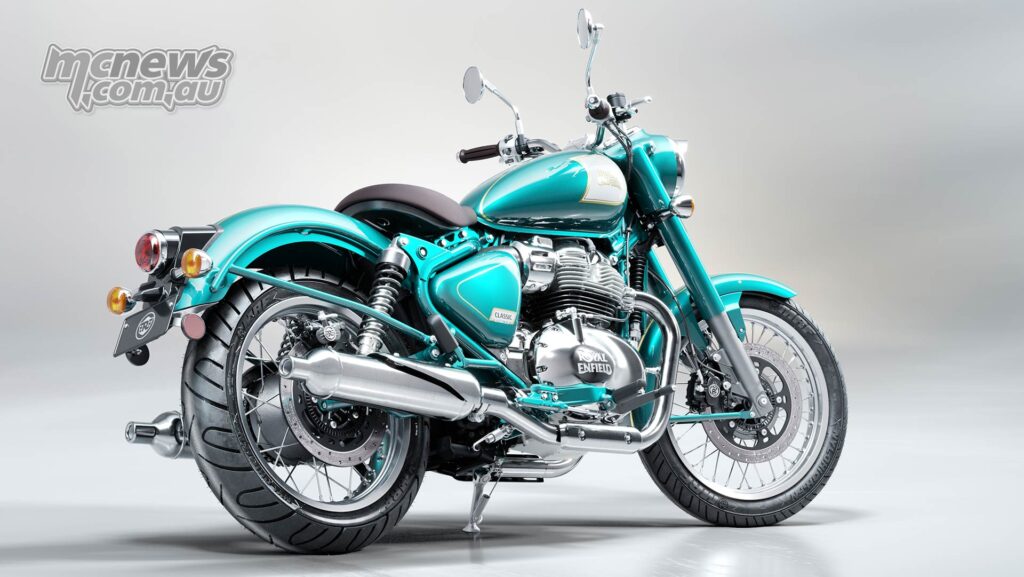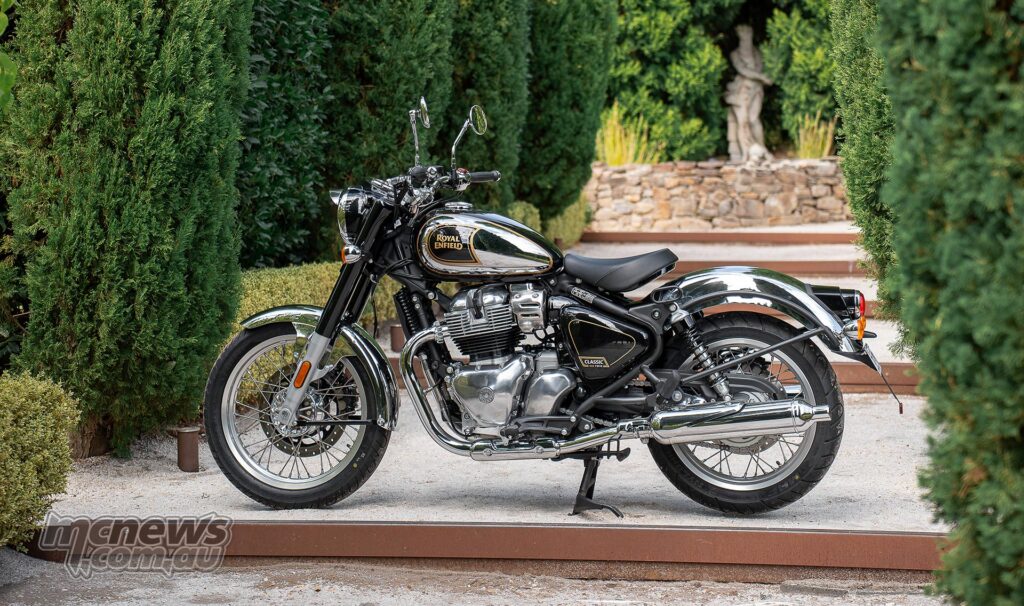Royal Enfield Classic 650 Review
Motorcycle Test
My first introduction to the new Classic 650 Royal Enfield was the line of bikes parked out the front of our digs for the night in Hepburn Springs. Moments later, I was on one and readying to hit the road. No messing about…

Taking off, everything felt natural enough; light but positive clutch and smooth torque off the bottom made pulling away from a stop a process that all just happened without a thought required.
I slotted in at the front of the group behind Royal Enfield’s lead rider, Chas Hern. Chas goes alright, good enough to have put an an 1190 Buell on the podium at Morgan Park when ASBK first visited there ten years ago.
Roughly 400 metres later, we approached a surprisingly tight and slightly uphill right-hander at a speed that was perhaps a bit brisker than I’d usually take on a first pass with this kind of bike. I gave the brakes a light brush to settle the chassis as I tipped it in, and once again, it all came together effortlessly.

The bike navigated the tight and somewhat tricky bend with ease, steering in nicely. Chas threw some sparks, then we peeled into the next turn, and on it went. You get the idea; this is an entirely unintimidating and unexpectedly entertaining bike. And despite the sparks, the ground clearance is actually pretty good, and you do have to be going some to scrape the stand.

Through faster turns, especially on rougher road surfaces, the bike’s limitations become apparent. That said, it never gets truly unruly. The suspension is fairly basic, but there’s a reasonable amount of travel, and while the damping isn’t as refined as I’d like, it’s probably better than most would expect at first glance.

After all, it’s Showa kit. The ride quality is miles ahead of what Harley used to deliver with the 883 and 1200 Sportsters. The front forks are inverted, separate-function big-piston units, and the twin rear shocks offer 90 mm of travel. So the bones are there, and it all comes together well enough.

Royal Enfield’s 650 parallel-twin is a peach of a motor. It is no powerhouse, as it is LAMS compliant, but few learner legal bikes pull from the basement as willingly as the Indian bike. It is just about impossible to stall and jumps away from the lights eagerly enough to stay ahead of all but the most determined traffic.

It is a smooth operator in every sense, with plenty of bottom-end torque. I often find its easy going character rubbing off on me, it isn’t interested in being hurried. It prefers to just go with the flow, man…

The gear ratios complement its laid-back, loping character perfectly; third gear will stretch past 100 km/h if needed. On the highway, the bike comfortably cruises at 130 km/h in top without feeling stressed or overworked. Even at speed, there are no unpleasant vibrations through the bars, seat, or pegs. That’s pretty impressive.
I’ve always loved the look of twin pipes on a bike, and the peashooter mufflers on the Classic suit it perfectly. That said, because they exit so far back, due to the bike’s long wheelbase, there’s not much aural feedback for the rider. Passersby get a pleasant, if subdued, plodding exhaust note, but very little of that carries forward to the rider.

I’d love a bit more bark from the exhaust, but those peashooters just fit the bike’s aesthetic so well that it’s hard to imagine swapping them out for something shorter. Maybe pulling some of the baffling out could do the trick, though if it’s not done right, it might end up sounding more like a wet fart in a tin can than anything remotely satisfying.

The large 320 mm single front rotor and twin-disc caliper provides adequate stopping power. It works well enough and suits the suspension package, but holy smokes, Batman, the rear brake has some power!

I noticed when looking at the bikes before the ride that the rear disc looked huge, and in practice, it proved to have the stopping power to match that look. I am struggling to remember a bike with such a powerful rear brake. The brake lever itself is quite modest in size but provides decent enough modulation to control that stopping power.

There is a twin-channel ABS system to back up the brakes, something that riders prone to being a bit too rough with their right clog will come to appreciate. The Classic does not have traction control.

The front brake and the clutch lever are adjustable for reach. Their rolled edges are quite pleasing to the eye and finger. The brake master-cylinder is also handsome enough, as is the Royal Enfield stamped centrepiece on the bars.

The mirrors are basic and old school but look and work fine enough, with no discernible vibration seen through them at speed. If I was to be harsh, the switch-blocks have a chromed plastic sort of look, but on further inspection, they are actually cast alloy that has then been chromed.
There is a handy and well-protected USB-C port situated under the left-hand switch-block. The useful Tripper navigation system is also standard in Australia.

Both the side-stand and the included centre-stand are painted in the same colour as the sub-frame and frame.
The pillion seat and sub-frame required to fit the rear seat also come standard at no extra cost. The passenger hardware takes around half an hour or so to fit, so it is not something you are going to take on and off on a regular basis.

Where the cockpit view fell short for me was in the quality of the paintwork on the large proboscis, or nacelle, that houses the instruments and headlight. I later learned the official name for this part is the ‘casquette’. The orange peel effect in the paint was clearly visible, and because it sat so squarely in my eye-line, it started to grate on me.

It wasn’t just specific to the ‘Vallam Red’ bike I was riding, as the black bike I photographed above had the same uneven-looking finish to the paint on the same surface.
I had to look up the colour, actually, as from my perspective, the Vallam Red looked more like a brown. Then again, the lighting during our late afternoon and evening ride wasn’t ideal, so that likely skewed my impression as to the hue. In bright sunlight, I am sure it would be a different story, as seen in the image below.

The teal option is quite striking at first glance, and my eye did keep getting drawn towards it. However, I think if taking one home for good, I might choose one of the slightly more subtle colourways.

The Black Chrome variant has a somewhat understated look that grows on you the more you look.

The saddle styling of the seat is done quite well. It really works from all angles and does a pretty reasonable take on being functional too, considering its fairly modest size compared to modern bikes.
The instrumentation is a combination of old and new. A large round speedometer with an LCD inset that displays the current fuel level and tripmeter functionality.

There is no doubt that the Classic is a very handsome motorcycle, but the ride quality is also better than I expected. It does its job of being a motorcycle, which, let’s face it, is its primary purpose, quite well indeed. It’s not just a form-over-function styling exercise, but a well sorted motorcycle that provides an entertaining ride without as many compromises as you might expect. It doesn’t handle as well as the Interceptor or Continental GT, but it isn’t really that far away.

I was actually looking for a kick-starter to complete the retro silhouette, but I am very thankful that it just starts with a button!
The Classic 650 provides an entirely fuss-free, back-to-basics motorcycle experience built on Royal Enfield’s already well-proven and very popular 650 platform, complete with a three-year unlimited kilometre warranty and three years of roadside assistance.

For those riders tossing up between the 350 and 650 offerings from Royal Enfield, I thoroughly recommend making the jump to the bigger bike. Everything about the riding experience is better on the 650 models. The brakes and suspension also get meaningful upgrades over the 350 variants, and that theme also carries through to the quality of the motorcycle in every aspect.

The Classic 650 starts from an introductory price of $11,190, ride away. Royal Enfield told us that early interest is huge and that the Classic 650 is on course to be second only to the Himalayan in popularity.

They will start landing on Royal Enfield dealer showrooms later this month. Early indications are that they are going to shift plenty of them. If you take one home yourself, let us know how you get on.
Check out the Royal Enfield Australia website for more information.

Royal Enfield Classic 650 Specifications
|
647.95 cc Parallel-twin, 4-stroke, SOHC |
|
|
Digital electronic ignition |
|
|
EFI (Electronic Fuel Injection) |
|
|
Steel Tubular Spine Frame |
|
|
Showa Upside-down telescopic fork, 43mm |
|
|
Showa Twin Shock, 90mm travel, adjustable preload |
|
|
Front Tyre (Spoked Wheel) |
|
|
Hydraulic Disc Brake, Single 320mm Ventilated disc, twin piston floating caliper |
|
|
Hydraulic Disc Brake, Single 270mm Ventilated disc, single piston floating caliper |
|
|
Kerb Weight (90% Fuel & Oil) |
|
|
Three years, unlimited kilometres |
|













